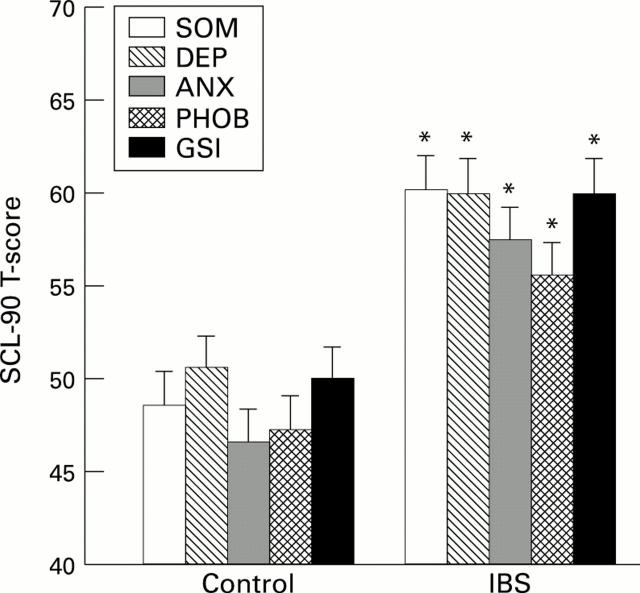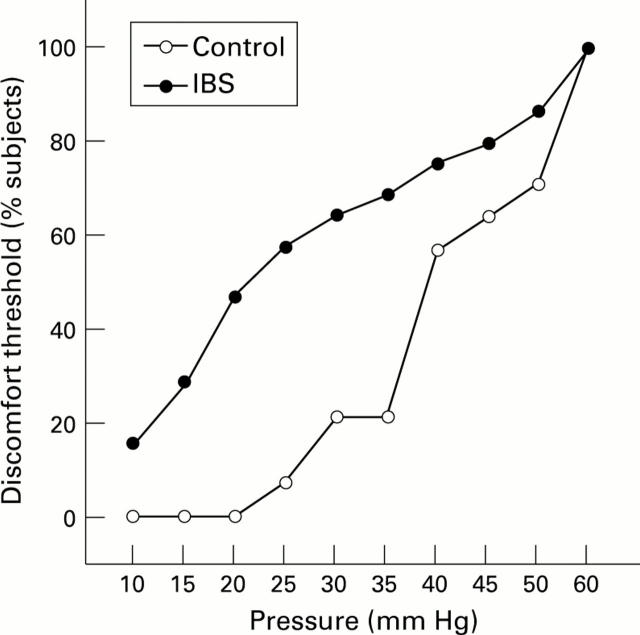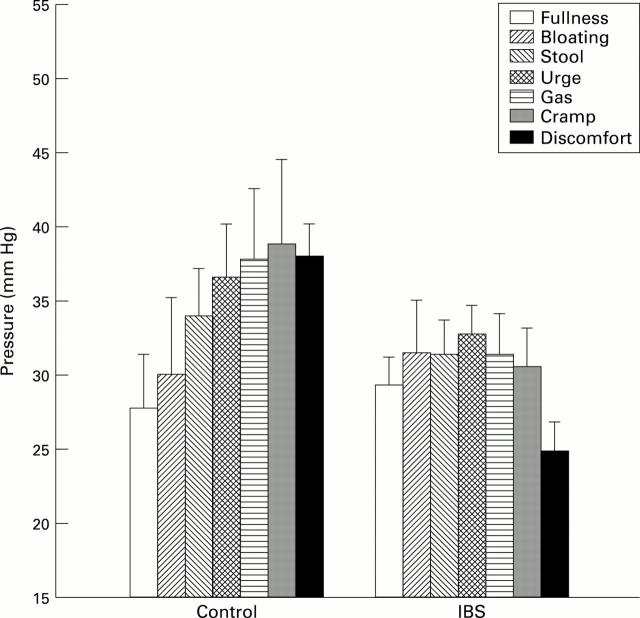Abstract
Background and aims—Visceral hyperalgesia has been implicated as a factor contributing to symptom generation in irritable bowel syndrome (IBS). However, previous studies using intestinal balloon distension have used psychophysical procedures which do not provide adequate and unbiased measures of visceral sensitivity. Methods—Three psychophysical tasks were examined in 45 patients with IBS (positive Rome criteria) and 14 controls using rectal balloon distension with a computerised distension device. Discomfort threshold and tolerance were assessed during an ascending series of phasic pressure stimuli and during an interactive threshold tracking procedure. In addition, stimulus response functions were generated from intensity and unpleasantness ratings of the rectal distensions. Results—Discomfort threshold and tolerance for the ascending stimuli were significantly lower for the patients with IBS compared with the controls. In contrast, discomfort thresholds during the tracking procedure and stimulus response curves for the ascending series were not different between the groups. A factor analysis of the psychophysical data was consistent with the presence of two distinct and unrelated perceptual alterations related to rectal distension: hypervigilance for visceral stimuli, manifested as lowered response criteria for using the descriptor "discomfort"; and rectal hypersensitivity, manifested as a lower discomfort threshold and left shift of the stimulus response curves. Conclusions—Patients with IBS as a group have a greater propensity to label visceral sensations negatively and show a lower tolerance for rectal balloon distension. A subgroup of patients also have baseline rectal hypersensitivity, assessed by unbiased measures of discomfort threshold and stimulus intensity judgements.
Keywords: irritable bowel syndrome; visceral hypersensitivity; pain threshold
Full Text
The Full Text of this article is available as a PDF (164.3 KB).
Figure 1 .
: SCL-90 scores for IBS and control groups. SOM, somatisation; DEP, depression; ANX, anxiety; PHOB, phobia; GSI, global symptom index. *p<0.05 in comparison with IBS group.
Figure 2 .
: Cumulative percentage of subjects reaching discomfort threshold during the ascending series by balloon pressure for the IBS and control groups.
Figure 3 .
: Average thresholds for first use of the various visceral sensations for the control and IBS groups from the ascending series. Error bars are SEM.
Figure 4 .
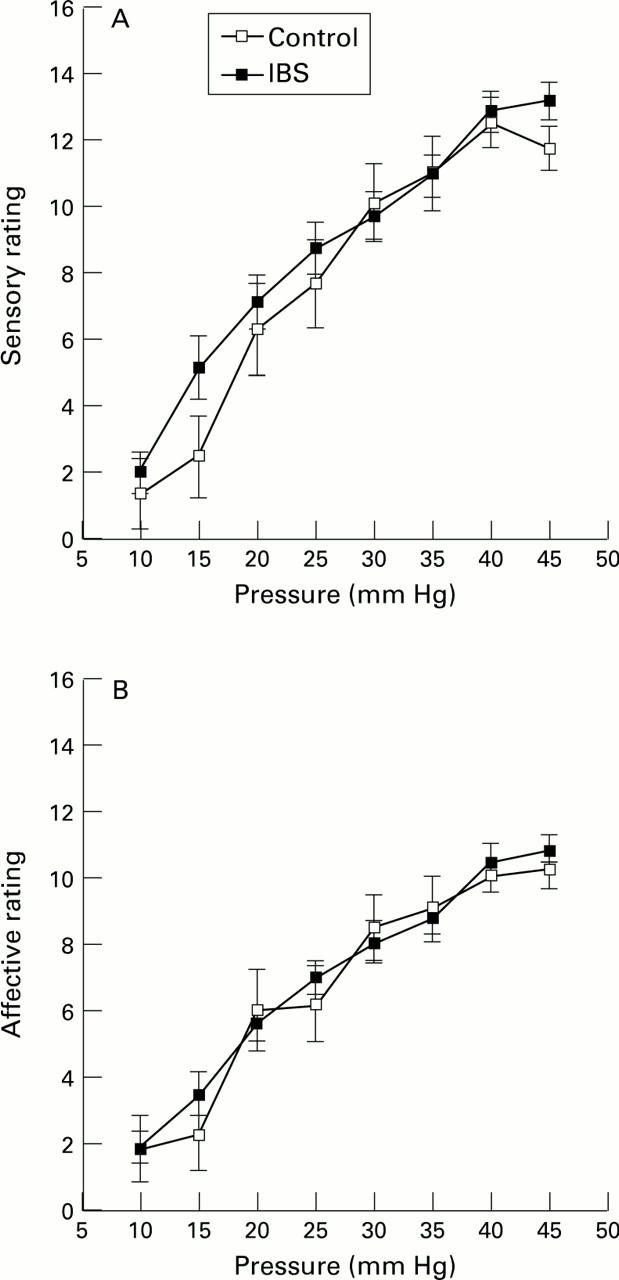
: S-R curves for the sensory (A) and affective (B) verbal descriptor scales during the ascending series of rectal distensions. Error bars are SEM.
Figure 5 .
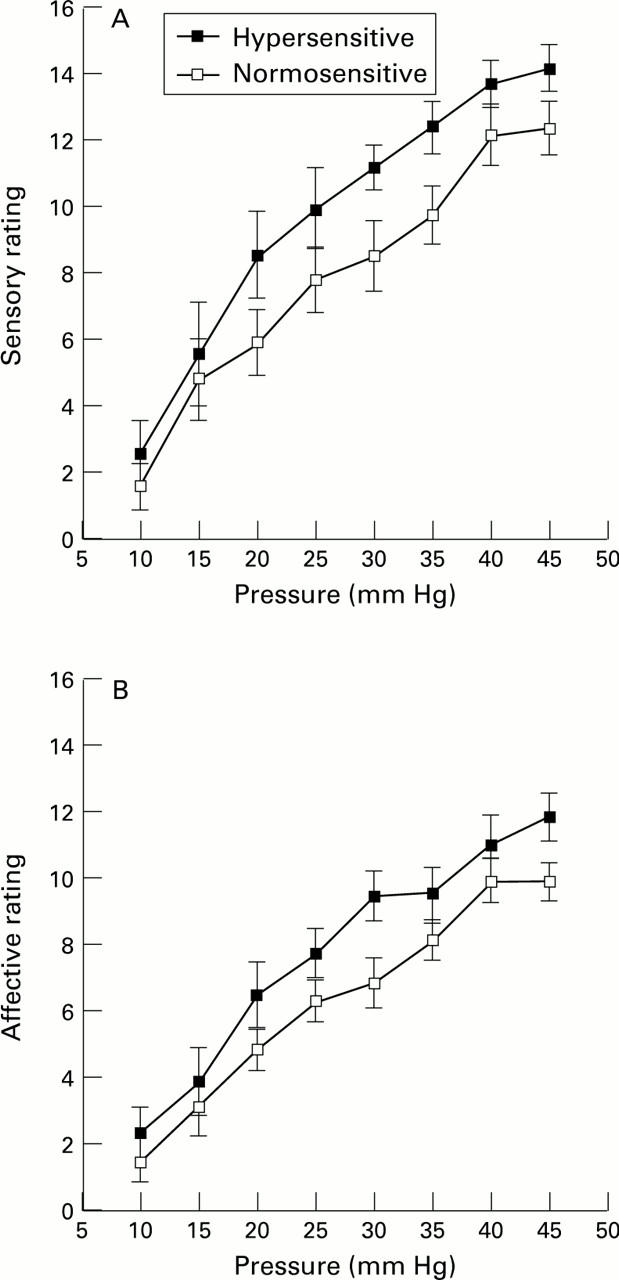
: S-R curves for the sensory (A) and affective (B) verbal descriptor scales during the ascending series of rectal distensions for hypersensitive and normosensitive patients with IBS. Error bars are SEM.
Selected References
These references are in PubMed. This may not be the complete list of references from this article.
- Bazzocchi G., Ellis J., Villanueva-Meyer J., Reddy S. N., Mena I., Snape W. J., Jr Effect of eating on colonic motility and transit in patients with functional diarrhea. Simultaneous scintigraphic and manometric evaluations. Gastroenterology. 1991 Nov;101(5):1298–1306. doi: 10.1016/0016-5085(91)90080-5. [DOI] [PubMed] [Google Scholar]
- Bradette M., Delvaux M., Staumont G., Fioramonti J., Bueno L., Frexinos J. Evaluation of colonic sensory thresholds in IBS patients using a barostat. Definition of optimal conditions and comparison with healthy subjects. Dig Dis Sci. 1994 Mar;39(3):449–457. doi: 10.1007/BF02088327. [DOI] [PubMed] [Google Scholar]
- CORNSWEET T. N. The staircrase-method in psychophysics. Am J Psychol. 1962 Sep;75:485–491. [PubMed] [Google Scholar]
- Devinsky O., Morrell M. J., Vogt B. A. Contributions of anterior cingulate cortex to behaviour. Brain. 1995 Feb;118(Pt 1):279–306. doi: 10.1093/brain/118.1.279. [DOI] [PubMed] [Google Scholar]
- Drossman D. A., McKee D. C., Sandler R. S., Mitchell C. M., Cramer E. M., Lowman B. C., Burger A. L. Psychosocial factors in the irritable bowel syndrome. A multivariate study of patients and nonpatients with irritable bowel syndrome. Gastroenterology. 1988 Sep;95(3):701–708. doi: 10.1016/s0016-5085(88)80017-9. [DOI] [PubMed] [Google Scholar]
- Gomborone J. E., Dewsnap P. A., Libby G. W., Farthing M. J. Selective affective biasing in recognition memory in the irritable bowel syndrome. Gut. 1993 Sep;34(9):1230–1233. doi: 10.1136/gut.34.9.1230. [DOI] [PMC free article] [PubMed] [Google Scholar]
- Gomborone J., Dewsnap P., Libby G., Farthing M. Abnormal illness attitudes in patients with irritable bowel syndrome. J Psychosom Res. 1995 Feb;39(2):227–230. doi: 10.1016/0022-3999(94)00126-p. [DOI] [PubMed] [Google Scholar]
- Gracely R. H., McGrath F., Dubner R. Ratio scales of sensory and affective verbal pain descriptors. Pain. 1978 Jun;5(1):5–18. doi: 10.1016/0304-3959(78)90020-9. [DOI] [PubMed] [Google Scholar]
- Kellow J. E., Eckersley C. M., Jones M. P. Enhanced perception of physiological intestinal motility in the irritable bowel syndrome. Gastroenterology. 1991 Dec;101(6):1621–1627. doi: 10.1016/0016-5085(91)90400-f. [DOI] [PubMed] [Google Scholar]
- LIPKIN M., SLEISENGER M. H. Studies of visceral pain: measurements of stimulus intensity and duration associated with the onset of pain in esophagus, ileum and colon. J Clin Invest. 1958 Jan;37(1):28–34. doi: 10.1172/JCI103581. [DOI] [PMC free article] [PubMed] [Google Scholar]
- Lembo T., Munakata J., Mertz H., Niazi N., Kodner A., Nikas V., Mayer E. A. Evidence for the hypersensitivity of lumbar splanchnic afferents in irritable bowel syndrome. Gastroenterology. 1994 Dec;107(6):1686–1696. doi: 10.1016/0016-5085(94)90809-5. [DOI] [PubMed] [Google Scholar]
- Manning A. P., Thompson W. G., Heaton K. W., Morris A. F. Towards positive diagnosis of the irritable bowel. Br Med J. 1978 Sep 2;2(6138):653–654. doi: 10.1136/bmj.2.6138.653. [DOI] [PMC free article] [PubMed] [Google Scholar]
- Mertz H., Naliboff B., Munakata J., Niazi N., Mayer E. A. Altered rectal perception is a biological marker of patients with irritable bowel syndrome. Gastroenterology. 1995 Jul;109(1):40–52. doi: 10.1016/0016-5085(95)90267-8. [DOI] [PubMed] [Google Scholar]
- Mertz H., Walsh J. H., Sytnik B., Mayer E. A. The effect of octreotide on human gastric compliance and sensory perception. Neurogastroenterol Motil. 1995 Sep;7(3):175–185. doi: 10.1111/j.1365-2982.1995.tb00223.x. [DOI] [PubMed] [Google Scholar]
- Munakata J., Naliboff B., Harraf F., Kodner A., Lembo T., Chang L., Silverman D. H., Mayer E. A. Repetitive sigmoid stimulation induces rectal hyperalgesia in patients with irritable bowel syndrome. Gastroenterology. 1997 Jan;112(1):55–63. doi: 10.1016/s0016-5085(97)70219-1. [DOI] [PubMed] [Google Scholar]
- Naliboff B., Mayer E. A. Sensational developments in the irritable bowel. Gut. 1996 Nov;39(5):770–771. doi: 10.1136/gut.39.5.770. [DOI] [PMC free article] [PubMed] [Google Scholar]
- Silverman D. H., Munakata J. A., Ennes H., Mandelkern M. A., Hoh C. K., Mayer E. A. Regional cerebral activity in normal and pathological perception of visceral pain. Gastroenterology. 1997 Jan;112(1):64–72. doi: 10.1016/s0016-5085(97)70220-8. [DOI] [PubMed] [Google Scholar]
- Welgan P., Meshkinpour H., Hoehler F. The effect of stress on colon motor and electrical activity in irritable bowel syndrome. Psychosom Med. 1985 Mar-Apr;47(2):139–149. doi: 10.1097/00006842-198503000-00005. [DOI] [PubMed] [Google Scholar]
- Whitehead W. E., Holtkotter B., Enck P., Hoelzl R., Holmes K. D., Anthony J., Shabsin H. S., Schuster M. M. Tolerance for rectosigmoid distention in irritable bowel syndrome. Gastroenterology. 1990 May;98(5 Pt 1):1187–1192. doi: 10.1016/0016-5085(90)90332-u. [DOI] [PubMed] [Google Scholar]



